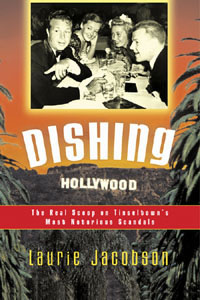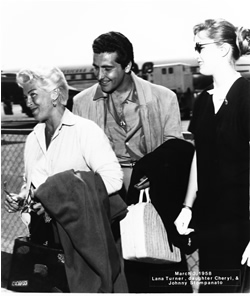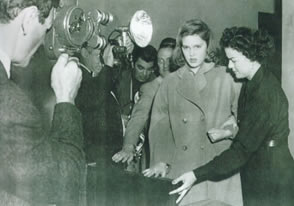 LANA TURNER
LANA TURNER
On a spring day in 1937, Judy Turner ditched typing class at
Hollywood High to get a Coke across the street at the Top Halt Malt
Shop. (Once and for all, it was not Schwab’s Drugstore.)
While quietly slurping her drink, a very important man asked her a very
important question: “Sweetheart, how’d you like to
be in the movies?” She thought for a moment, then shot back,
“I’ll have to ask my mother.” Mama Turner gave
the nod and a teenage star was born.
Lana Turner’s talent in a sweater left guys gasping for
air. She started in “Andy Hardy” kid stuff, but soon
dazzled audiences in films like: “Ziegfeld Girl” and “Johnny
Eager”. As a top WWII pin-up girl, she inspired many an
enlisted man to come back home to mama. After the war, MGM turned up
the heat, transitioning her to full-on glamorous movie star in films
like “The Postman Always Rings Twice” and “The Bad
and the Beautiful”. By the ‘50s, she was queen of
MGM. Beauty, wealth, legions of adoring fans and an Oscar nomination
for “Peyton Place” – Lana had it all – all but
true love.
Lana’s luck with men was rotten. She was a bad
shopper. Fan magazines followed her string of broken romances
with Artie Shaw, Sinatra, Howard Hughes, Tyrone Power, Fernando Lamas
and more. By 1957, she’d been married four times; her lifetime
total would reach seven. With husband #2, actor Stephen Crane,
she had her only child, a daughter, Cheryl. As a mother, Lana
was a better bride. It was her world -- everyone else just lived
in it. She was too busy with her career to notice when husband
#4, screen Tarzan, Lex Barker, began sexually abusing poor Cheryl.
When she found out, she held a gun to the sleeping bastard’s head,
but couldn’t pull the trigger. Instead, she sent the big
ape packing and Cheryl to boarding school. With Cheryl gone, Mama
quickly found another lover. Now she’d had trouble with
men in the past, but she didn’t know trouble till now.
In 1958, Lana picked a real doozie: small-time hood and big-time
ladies man, Johnny Stompanato, a henchman for mobster Mickey Cohen.
Good looking in a smarmy sort of way and apparently gifted in the sack,
he made a good living off lonely, rich women like Lana. So what
if he knocked her around a little? She thought it was exciting...to
a point.
April 4th, Cheryl, 14, is home from school, lucky for Lana.
Friends say she had been trying to dump the loser for awhile, but he
was not going quietly. She gave expensive gifts, took him to “A”
list affairs. She planned to take him to the Academy Awards, but
this night she tells him he’s not going there or anywhere with
her. He slaps her, tells her if she doesn’t take him, he’ll
ruin her face so she’ll never work again. Cheryl hears everything
outside the bedroom door. Terrified, she runs downstairs to grab
a kitchen knife and charges back upstairs. As she bursts in the
room., Stompanato turns toward her and somehow, the knife accidentally
plunges into his stomach.
When a movie star is involved in a crime, the last person they
want to see is a cop. For four decades, the first person was Jerry Geisler,
attorney to the stars. He defended Chaplin, Flynn, Mitchum, Bugsy
Seigel, even handled one of Marilyn Monroe’s divorces. And
now Lana. “Get Me Geisler” rushed to Bedford Drive.
Some say Johnny was still alive and Geisler let him bleed out.
The rumor that won’t die is that Lana killed Johnny and Geisler
convinced her to let Cheryl, a minor, take the fall. One thing’s
for sure: he made decisions as to how this thing was going down and
Lana and Cheryl never, ever veered from their story. Geisler accompanied
the duo to the Beverly Hills Police Department where Cheryl, confused
and scared stiff, was fingerprinted and booked on suspicion of murder.
The next day, the world heard the news. And it was very big news.
Lana and Johnny’s lurid love affair exploded across the
headlines. Not since Mary Astor's diary had a star's private life been
so public. Overnight, the country's take on Turner took a nosedive.
Nobody’d ever given much thought to her maternal side, least of
all Lana. As a whole, the public felt “Life with Lana”
was no place for a young girl. Cheryl was the real victim here.
Many damned Lana, including top columnist Hedda Hopper. "My heart
bleeds for Cheryl!” cried Hopper, calling Turner "a hedonist
without subtlety...so preoccupied with her design for living...Cheryl
isn't the juvenile delinquent; Lana is." Even the Hollywood
Reporter -- founded by Billy Wilkerson, the
man who had discovered the teenage Turner in that malt shop -- pointedly
wrote that the "town's sympathy is with Steve Crane and his daughter."
 The press build-up was pure Hollywood: Stompanato's funeral;
Turner's insistence that the hoodlum was an "unwelcome" presence
in her life; his brother's announcement that Johnny was stabbed while
lying down. The coup de Gras came two days before the inquest
when "Lanita's" love letters to her Johnny, filled with burning
desires, were plastered across front pages worldwide -- a little payback
from Mickey Cohen, Stompanato's pal.
The press build-up was pure Hollywood: Stompanato's funeral;
Turner's insistence that the hoodlum was an "unwelcome" presence
in her life; his brother's announcement that Johnny was stabbed while
lying down. The coup de Gras came two days before the inquest
when "Lanita's" love letters to her Johnny, filled with burning
desires, were plastered across front pages worldwide -- a little payback
from Mickey Cohen, Stompanato's pal.
Geisler arranged for Cheryl to be excused from the coroner's
inquest. That made Lana the star of the show. And what a
show. Everything that was important to Lana was on the line: her
life, her career, her public image and oh yeah, her daughter.
The morning of the inquest, as hundreds of her fans gathered downtown,
Lana's make-up and hair people were giving her the works at her Beverly
Hills home. She entered that courtroom “camera ready”
for the greatest performance of her life. ABC and CBS jointly
filmed the proceedings for television while broadcasting them live on
radio. In the hushed, sweltering Los Angeles courtroom, Lana Turner
breathlessly explained how her teenage daughter came to murder her gangster
boyfriend. It was the stuff dreams were made of.
Only the clicking of cameras could be heard during Turner's
62-minute anguished testimony. Weeping and wringing her hands,
she described how Cheryl rushed into the bedroom, knife in hand, after
over-hearing Stompanato threaten her.
"Everything happened so fast...I never saw the knife...I
thought she had hit him in the stomach with her fist." Sobbing,
she told of breathing air "into his semi-open lips...my mouth against
his." She choked, "He was dying." Oh,
brother.
The hearing lasted three hours. The jury returned a verdict
in less than twenty minutes: justifiable homicide. Mickey
Cohen griped to the press, "It's the first time in my life I've
ever seen a dead man convicted of his own murder. So far as that jury
was concerned, Johnny just walked too close to that knife."
So go figure. After all the negative publicity, Lana’s
career was barely affected. As the '50s neared a close and America
settled cheerily into the suburbs, the public created the happy ending
they needed to see. Cheryl went to live with her grandmother.
The world had one less cheap hood in it. And Lana Turner would
carry on, sadder, but wiser. At her next movie, fans cheered her
image, shouting, "We're on your side, Lana!" Turner
continued to star in films of the '60s and '70s -- two of which, "Imitation
of Life" and "Madame X", drew shamelessly on her real
life troubles. P.S. The public loved them.
Even though Lana probably never boiled water without help,
she offered up her favorite recipe:

SHRIMP SCAMPI
Serves 4
|
16 medium to large shrimp
2 cloves crushed garlic
¼ stick of butter or margarine
¼ cup olive oil
|
2 Tbs parsley flakes or fresh
1 tbs. Lemon juice
1 tsp. salt
¼ tsp. Pepper |
Split
shrimp, remove legs, veins and shell. Leave tails on. Heat
butter and oil, add garlic, parsley, lemon juice, salt and pepper.
Put sauce on flesh side of shrimp and marinate for one hour. Place
shrimp in baking pan flesh side up and broil about
6 inches from heat for six minutes. Serve hot.



